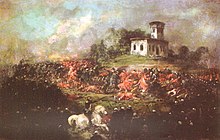Battle of Pavón
| Battle of Pavón | |||||||
|---|---|---|---|---|---|---|---|
| Part of War between the Argentine Confederation and the state of Buenos Aires | |||||||
 Battle of Pavón by Ignacio Manzoni at Museo Mitre |
|||||||
|
|||||||
| Belligerents | |||||||
|
|
|
||||||
| Commanders and leaders | |||||||
| Bartolomé Mitre | Justo José de Urquiza | ||||||
| Strength | |||||||
|
Total: 15,000 - 16,000 9,000 infantry 6,000 horsemen 1,000 artillerymen 35 cannons |
Total: 16,000 - 18,000 5,000 infantry 11,000 horsemen 2,000 artillerymen 42 cannons |
||||||
| Casualties and losses | |||||||
| 64 officers and 162 soldiers killed 500 wounded |
1,200 - 1,300 dead and wounded 1,650 - 1,800 prisoners 32 -37 guns, 11 flags, 3,000 rifles, 5,000 horses |
||||||
The Battle of Pavón was a key battle of the Argentine civil wars. It was fought in Pavón in Santa Fé Province, Argentina, on September 17, 1861, between the Army of the State of Buenos Aires, commanded by Bartolomé Mitre, and the Army of Republic of the Argentine Confederation commanded by Justo José de Urquiza. The withdrawal of Urquiza left the field to Mitre.
It led to the dissolution of the national government and the reincorporation of Buenos Aires Province into the Argentine Republic as a dominant member of the nation. Governor Bartolomé Mitre would act as interim President, ratified by the National Congress, and then as the first President of a unified Argentine Republic.
During most of the 19th Century, Argentine history was defined by the theoretical, political and military confrontation between two postures:
One difference between the porteños from Buenos Aires and people from the provinces was that the former did not align directly with the two political parties of the time. Unitarians and Federalists existed both in the capital and in the provinces. Even though they were against each other politically, when it came to defend their own local interests, they joined to confront their common enemy (be it the capital or the provinces, whatever the case may be).
Since the secession of Buenos Aires Province on 11 September 1852, on the aftermath of the Battle of Caseros, Argentina was divided between two competing states, the Argentine Confederation and the State of Buenos Aires. The Battle of Cepeda (1859) and the subsequent Pact of San José de Flores of 1860 set the conditions for Buenos Aires to rejoin the Confederation (which came to be called Argentine Republic since the 1860 reform of the Constitution on Buenos Aires request). However, both sides would clash again soon after.
...
Wikipedia
